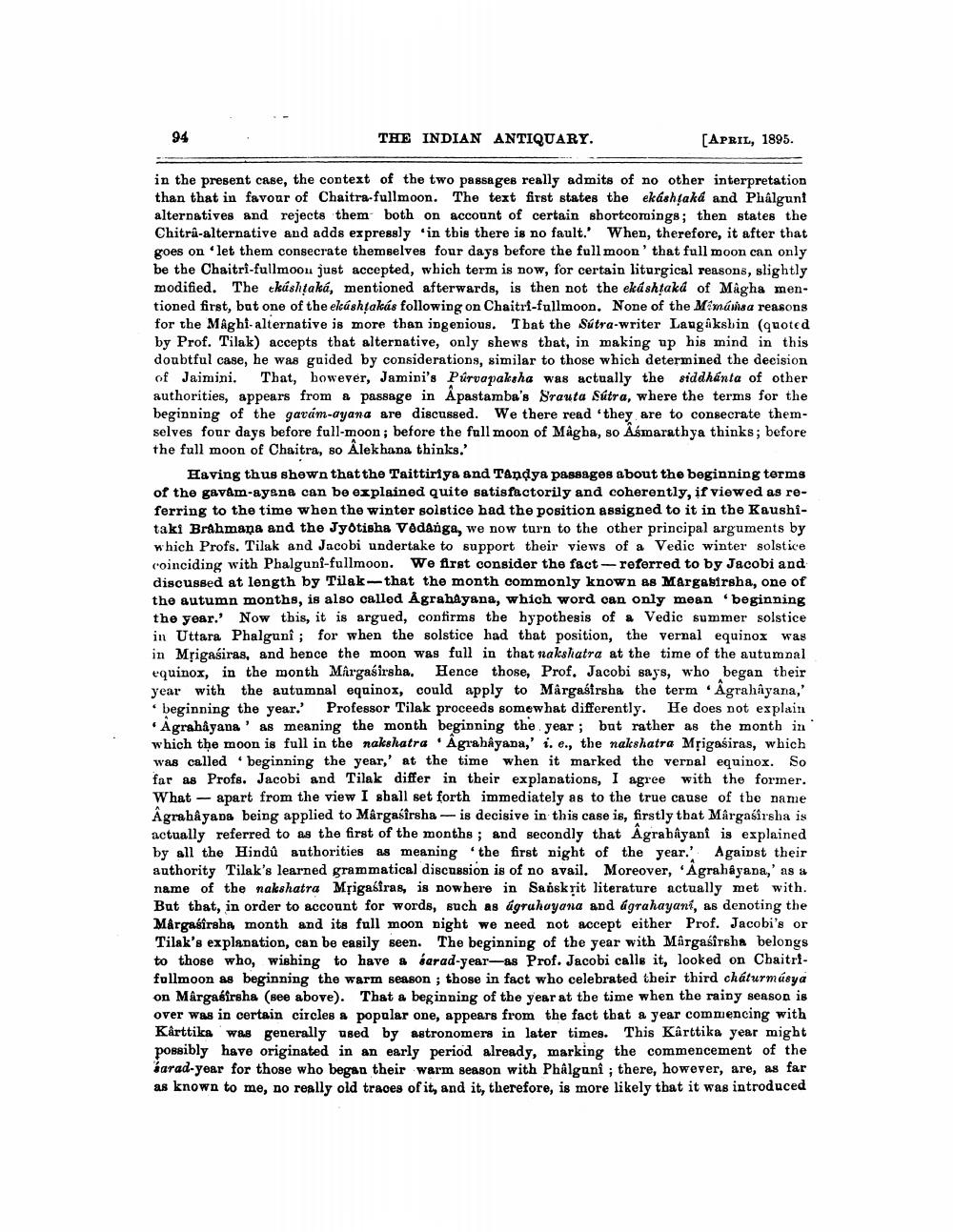________________
94
THE INDIAN ANTIQUARY.
[APRIL, 1895.
in the present case, the context of the two passages really admits of no other interpretation than that in favour of Chaitra-fullmoon. The text first states the ekáshtaka and Phâlgunt alternatives and rejects them both on account of certain shortcomings; then states the Chitra-alternative and adds expressly 'in tbis there is no fault. When, therefore, it after that goes on let them consecrate themselves four days before the full moon' that full moon can only be the Chaitri-fullmoou just accepted, which term is now, for certain liturgical reasons, slightly modified. The tkushtaká, mentioned afterwards, is then not the ekáshtakd of Magha mentioned first, but one of the eláshtakás following on Chaitri-fullmoon. None of the Mináisa reasons for the Maghi-alternative is more than ingenious. That the Sútra-writer Langåksbin (quoted by Prof. Tilak) accepts that alternative, only shews that, in making up his mind in this doubtful case, he was guided by considerations, similar to those which determined the decision of Jaimini. That, bowever, Jamini's Púrvapaksha was actually the siddhanta of other authorities, appears from a passage in Apastamba's Srauta Sútra, where the terms for the beginning of the gavám-ayana are discussed. We there read 'they are to consecrate themselves four days before full-moon; before the full moon of Magba, so Asmarathya thinks; before the full moon of Chaitra, so Alekhana thinks.'
Having thus shown that the Taittiriya and Tandya passages about the beginning terms of the gavam-ayena can be explained quite satisfactorily and coherently, if viewed as referring to the time when the winter solstice had the position assigned to it in the Kaushitaki Brahmana and the Jyotisha Vedanga, we now turn to the other principal arguments by which Profs. Tilak and Jacobi undertake to support their views of a Vedic winter solstice coinciding with Phalguni-fullmoon. We first consider the fact - referred to by Jacobi and discussed at length by Tilak-that the month commonly known as MArgabirsba, one of the autumn months, is also called Ågrabayana, which word can only mean beginning the year. Now this, it is argued, confirms the hypothesis of a Vedic summer solstice in Uttara Phalgunî; for when the solstice had that position, the vernal equinox was in Mrigasiras, and hence the moon was full in that nakshatra at the time of the autumnal equinox, in the month Margaśirsha. Hence those, Prof. Jacobi says, who began their year with the autumnal equinox, could apply to Mârgaśirsha the term Agrahayana,'
beginning the year. Professor Tilak proceeds somewhat differently. He does not explain • Agrahảyana' as meaning the month beginning the year ; but rather as the month in which the moon is full in the nakshatra Agrahảyana,' i. e., the nakshatra Mrigaśiras, which was called beginning the year,' at the time when it marked the vernal equinox. So far as Profs. Jacobi and Tilak differ in their explanations, I agree with the former. What - apart from the view I shall set forth immediately as to the true cause of the name Âgrahảyada being applied to Margasîrsha - is decisive in this case is, firstly that Margasirsha is actually referred to as the first of the months; and secondly that Agrahîyani is explained by all the Hindú authorities as meaning the first night of the year.! Against their authority Tilak's learned grammatical discussion is of no avail. Moreover, Agrahayana,' as a name of the nakshatra Mrigasiras, is nowhere in Savskrit literature actually met with. But that, in order to account for words, such as ágrahoyana and agrahayani, as denoting the Mårgasîrsha month and its full moon night we need not accept either Prof. Jacobi's or Tilak's explanation, can be easily seen. The beginning of the year with Margasîrsha belongs to those who, wishing to have a sarad-year-as Prof. Jacobi calls it, looked on Chaitrifullmoon as beginning the warm season; those in fact who celebrated their third cháturmúsya on Mârgasirsha (see above). That a beginning of the year at the time when the rainy season is over was in certain circles a popular one, appears from the fact that a year commencing with Kårttika was generally used by astronomers in later times. This Kârttika year might possibly have originated in an early period already, marking the commencement of the sarad-year for those who began their warm season with Phålguni ; there, however, are, as far as known to me, no really old traces of it, and it, therefore, is more likely that it was introduced




